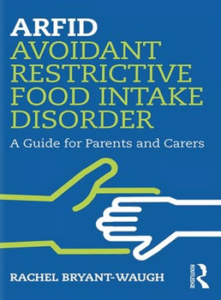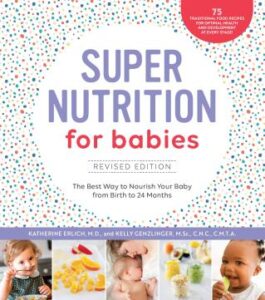Healthy Feeding and Nutrition
This topical guide will introduce you to important books, videos, and information resources available from the EI Clearinghouse and other sources. Contact us via online form or by phone (1-877-275-3227) to request a resource listed below (or ask your local public librarian). Note that some videos may be viewed online, and journal titles will take you to the publisher’s homepage.
Table of Contents

EIC Resources
Books
Families come in all shapes and sizes and from all sorts of backgrounds. They speak various languages, eat different sorts of food, live in different kinds of homes and celebrate special occasions in a variety of ways. This book lets children explore questions such as “What is a family?’, ‘What different sorts of families are there?’ and more.
This book’s rhyming text, in parallel text in English and Spanish, offers plenty of prompts for caregiver-child interaction to strengthen secure attachment, from snack time to mealtime and every time in between.
Explore a rainbow of delicious foods in this book. What green vegetable looks like a tree? Broccoli! Can you find a fruit that’s small and yellow? Lemon! Can you pick out two berries so red and sweet? Raspberry and strawberry!
Baby-led weaning is the healthy, natural way to start your baby on solid foods–no stress, no fuss, no mush! This tenth anniversary edition of the definitive guide explains all its benefits.
This book reveals secrets for better breast and bottle feeding and feeding development for babies from birth to the toddler years.
Food Chaining helps you identify the reasons behind your child’s picky eating habits — be it medical, sensory, or because of allergies. Then, with a simple, 6-step method centered around taste, temperature, and texture, target foods are selected that are similar to the ones your child likes, gradually expanding to all food groups.
A father and child grow vegetables and then make them into a soup.
This book presents 5 steps (built around the clinically proven STEPS+ approach―Supportive Treatment of Eating in PartnershipS) that transform feeding and meals so your child can learn to enjoy a variety of foods in the right amounts for healthy growth.
This adorable rhythmic book will turn your fussy eaters into veggie-loving superheroes! Because haven’t you heard?…Vegetables are superhero fuel!
The perfect resource for new and experienced parents alike, Natural Baby Food is filled with over 150 delicious, nutritious recipes to please even the pickiest palate. Divided into concise, clear recipe sections for different stages of your baby’s growth, Natural Baby Food is the quick, reliable resource to help any parent keep their baby or toddler happy and healthy throughout their development.
This book provides parents with information and strategies to meet the dietary needs of their children and includes charts to help parents determine if their child is overweight, too thin, or too small.
This book explains how to expand your family’s food horizons, avoid the picky eater trap, identify special feeding needs, and put joy back into mealtimes.
Potock guides parents along every step of the way, from “to bib or not to bib?” and how to wrangle a “food thrower” to the merits of a “nibble tray” for hangry toddlers and considerations for special needs. Raising a mindful, healthy eater s just a bite away!

This book is an accessible summary of a relatively recent diagnostic term and covers common questions encountered by parents or carers whose child has been given a diagnosis of ARFID or who have concerns about their child. It also includes a wealth of practical tips and suggested strategies to equip parents and carers with the means to take positive steps towards dealing with the problems ARFID presents.
This book includes accessible tips throughout and a chapter of recipes to promote brain health. It is an essential guide to understanding the interplay of brain health and nutrition, and supporting families to build a diet that optimizes brain function and health.
This book provides simple tips and tricks on how to approach baby-led weaning like pro, how to help a child develop healthy eating habits from the very beginning, and turn weaning into a process that’s fun for the entire family.

Based on the recommendations of nutrition pioneer Dr. Weston A. Price and traditional food principles, this book provides parents and caregivers with information on all aspects of nutrition and feeding, including when to introduce meat in a child’s diet, healthier alternatives to dairy and soy, and introducing solid foods.
This book shares expert nutritional advice, parental insights, and more than 230 easy recipes for babies, toddlers, and families.
This humorous book, written by two working moms, offers parents suggestions and tips to get kids to eat healthier food, includes cooking instructions and more than 100 kid-tested recipes.
This book discusses the nutritional side of the Brain Balance program, a scientifically developed program for feeding kids with special needs, featuring guidelines, tips, and kid-friendly recipes all designed to help busy parents feed picky kids in a beneficial way.
Chloe loves going to school, but lately something is different. Chloe has all the ingredients of a great friend – kindness, empathy, compassion, and more. Chloe wonders, “What do you do when friends don’t treat you with kindness?” Find out how this brave girl navigates the trials and tribulations that pop up on her way to discovering the recipe for lasting friendship.
The Kid-Friendly ADHD & Autism Cookbook provides a current review of the commonly used diets for the treatment of ADHD and autism, and recipes appropriate to specific diets. It also provides suggestions for feeding picky eaters, including those with texture issues.
This book provides practical, easy-to-follow advice to help you navigate the nutrition issues, medical conditions, and parenting concerns that accompany feeding.
When the fussy young prince turns his nose up at his royal breakfast, the king and queen decide to hit the road. The whole royal family embarks on a madcap global adventure to Mexico, India and beyond in search of something the prince will eat.
Videos and Media
This video provides parents, caregivers and child care providers with information to help young children develop social, emotional and cognitive skills. Topics include exercise, healthy eating, preventing obesity, sleep, diabetes, asthma, and more.
This video presents pediatric feeding strategies that will allow you to manage medical issues related to respiration, airway, and aspiration in non-medical environments, expand food repertoire wherever your client eat, design effective individual and group feeding environments in school settings, and conduct tele-visits that really work. It discusses the challenges and advantages associated with adapting pediatric feeding therapy in a variety of settings including home, school, medical, and telehealth. The presenter touches on dietary modifications, case law reviews, and the importance of written plans for young children with feeding difficulties.
This guide and DVD is a self-study publication to be used for continuing professional development. It includes video examples of evaluation, worksheets, and parent handouts.
Every day, we share meals with our family. When we have young children, mealtimes can be fun or stressful. This video talks about what is happening developmentally for young children and what we can do to make mealtimes go more smoothly.
This video provides the parents of typically developing infants with basic information on feeding and nutrition for toddlers.
Using MyPlate and the USDA’s dietary guidelines, this video shows how meals can include a variety of nutritious foods, how to determine appropriate portion sizes, how to make snacks healthy, and how to encourage physical activity. Also discusses common concerns about sugar, fat, and picky eaters. Shows how busy families can eat healthy.
This video presents basics of the Standard American Diet (S.A.D.) as it relates to mental health, how poor nutrition can mimic mental health symptoms, the impact of sugar, inflammation, and “fake” nutrition on brain function, and recommendations and resources you can make for kids and families.
This video uses demonstrations to introduce the parents of infants and young children to the process of tube feedings.
Organizations
Help your kids and family live more healthfully with these nutrition and physical activity resources, tips and articles.
This Web site contains tips, parent stories, articles, and other resources for parents and professionals who feed infants and young children with special feeding challenges.
Author of several books on feeding and mealtimes, this Web site contains information for parents of typically developing infants and young children.
The U.S. Department of Agriculture’s MyPlate has information and materials for children. Get kids started on a healthy eating adventure with these games and activities!
Articles
This article provides a review of symptoms, causes, and available resources to aid in the identification and treatment of swallowing difficulties in young children.
This review gathers current research on the types of feeding problems and interventions used with children with ASD.
This article provides guidance for parents on how to respond to ‘fussy eating’ in toddlers and offers a range of useful tips and strategies.
This article discusses how sensory processing issues can affect the feeding behavior of infants and toddlers. The article provides strategies for assessment and treatment as well as additional resources.
Web Resources
Feeding infants and toddlers can be an intense and emotional (positive and negative) experience for both parent and child. This factsheet describes skills related to feeding and eating, specific feeding skills, taste, texture & food preferences, and appetite regulation for infants and toddlers.
Good nutrition is basic for supporting preschoolers’ healthy growth while avoiding obesity. Parents can offer the foods that children need and help them develop good eating habits. Also in Polish and Arabic.
Children can easily drink a lot of juice because juice tastes good. However, too much juice in your child’s diet can contribute to other problems, like poor nutrition, obesity, and tooth decay.
“Picky” eating is when a child (or adult) refuses foods often or eats the same foods over and over. Here’s what to do and what not to do with your picky eater.
Children’s nutrition doesn’t have to be frustrating. Consider these strategies to avoid power struggles and help the picky eater in your family eat a balanced diet.
Pediatric dysphagia (swallowing disorder) occurs when a child has difficulty swallowing food or liquids. This can occur in any phase of the swallowing process.
Snacks are an important part of children’s daily nutrition in child care as well as at home. Be aware that a young child may eat little one day and a lot the next. In planning healthy snacks, consider food safety and known allergies as well as “snack appeal”!

